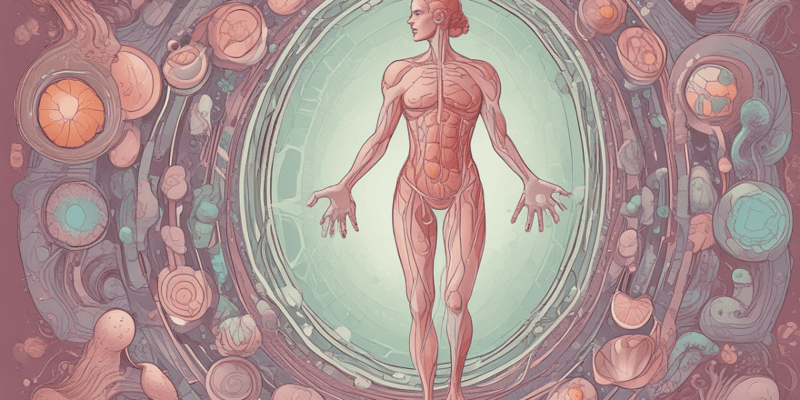Questions and Answers
What are the primary sex organs in the male reproductive system?
The main function of the testes is to secrete steroid sex hormones only.
False
What are the gametes produced by the male reproductive system?
sperm
The sperm travels through a system of ducts, including the epididymis and __________.
Signup and view all the answers
Which accessory gland contributes to the formation of semen?
Signup and view all the answers
Match the following male reproductive structures with their functions:
Signup and view all the answers
The scrotum serves to protect the testes from environmental factors.
Signup and view all the answers
Name one type of hormone secreted by the male reproductive system.
Signup and view all the answers
Which of the following structures is responsible for the attachment of the ovary to the lateral pelvic wall?
Signup and view all the answers
The fimbriae are finger-like projections located at the end of the uterine tube.
Signup and view all the answers
Name the pouch that is located between the rectum and the uterus.
Signup and view all the answers
The ________ is the structure that connects the vagina to the external environment.
Signup and view all the answers
Match the following female reproductive structures with their functions:
Signup and view all the answers
What is the diploid chromosomal number referred to as?
Signup and view all the answers
Spermatogenesis occurs in the oviducts.
Signup and view all the answers
What type of cell division is involved in gamete formation?
Signup and view all the answers
Gametes have a chromosomal number of ______.
Signup and view all the answers
Match the terms with their definitions:
Signup and view all the answers
How many daughter cells are produced from one meiosis?
Signup and view all the answers
Mitosis results in daughter cells that are genetically identical to the parent cell.
Signup and view all the answers
What introduces genetic diversity during meiosis?
Signup and view all the answers
The resulting daughter cells from meiosis are usually termed ______.
Signup and view all the answers
During which phase do homologous chromosomes separate in meiosis?
Signup and view all the answers
What structure is responsible for supporting the ovary?
Signup and view all the answers
The fimbriae are located at the end of the uterine tube and play a role in the transport of the ovum.
Signup and view all the answers
What is the name of the cavity of the uterus?
Signup and view all the answers
The _____ is the outermost layer of the uterine wall.
Signup and view all the answers
Match the uterus layers to their descriptions:
Signup and view all the answers
Which ligament connects the uterus to the side of the pelvis?
Signup and view all the answers
What happens to the endometrium during the proliferative phase?
Signup and view all the answers
The ampulla is part of the uterine tube.
Signup and view all the answers
Ovulation occurs on day 14 of the secretory phase.
Signup and view all the answers
What blood vessels supply the uterus?
Signup and view all the answers
What hormonal change prompts the functional layer of the endometrium to become a secretory mucosa?
Signup and view all the answers
During the secretory phase, thickened mucus forms a __________ that blocks entry of more sperm.
Signup and view all the answers
Match the following phases of the menstrual cycle with their descriptions:
Signup and view all the answers
What effect does rising estrogen have during the proliferative phase?
Signup and view all the answers
The secretory phase is the most variable phase in duration of the menstrual cycle.
Signup and view all the answers
What happens to the spiral arteries at the end of the secretory phase if fertilization does not occur?
Signup and view all the answers
Study Notes
Reproductive System Overview
- Male and female reproductive systems consist of primary sex organs (gonads) that produce gametes and secrete steroid sex hormones.
- Male gonads: testes produce sperm and androgens.
- Female gonads: ovaries produce ova and secrete estrogens and progesterone.
- Accessory reproductive organs include ducts, glands, and external genitalia.
Male Reproductive System Anatomy
- Testes are sperm-producing gonads located within the scrotum.
- Sperm travels through ducts: epididymis, ductus deferens, ejaculatory duct, and urethra.
- Accessory glands include seminal vesicles, prostate, and bulbourethral glands.
Spermatogenesis
- Defined as the production of sperm in seminiferous tubules.
- Most body cells are diploid with 46 chromosomes; gametes are haploid with 23 chromosomes.
- Meiosis involves two cell divisions, resulting in four genetically diverse daughter cells.
Meiosis vs. Mitosis
- Meiosis: two rounds of division (meiosis I & II) with one DNA replication.
- Involves genetic diversity as daughter cells are different from the original cell.
- During mitosis, daughter cells remain diploid, while meiosis results in haploid cells.
Female Reproductive System Anatomy
- Includes structures such as ovaries, uterine tubes (fallopian tubes), uterus, and vagina.
- Ovaries are connected by suspensory ligaments and produce eggs and hormones.
- Uterus comprises three layers: endometrium (inner), myometrium (middle), and perimetrium (outer).
Uterine (Menstrual) Cycle
- Days 1-5: Menstrual phase, shedding of the functional layer of the endometrium.
- Days 6-14: Proliferative phase where estrogen levels rise, thickening the endometrial lining.
- Days 15-28: Secretory phase, endometrium prepares for embryo implantation following ovulation.
- If no fertilization occurs, the corpus luteum degenerates, leading to the next menstrual cycle.
Hormonal Regulation
- Rising estrogen levels stimulate endometrial growth and the synthesis of progesterone receptors.
- Progesterone from the corpus luteum maintains uterine lining for potential implantation.
- Cervical mucus changes consistency to facilitate sperm passage during ovulation.
Studying That Suits You
Use AI to generate personalized quizzes and flashcards to suit your learning preferences.
Description
Test your understanding of the male reproductive system, including the location, structure, and function of its organs. This quiz covers hormonal regulation and the roles of primary sex organs. Perfect for reinforcing your knowledge in reproduction.




